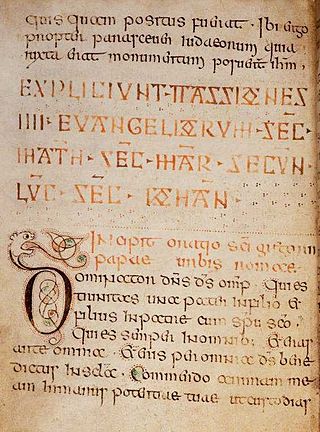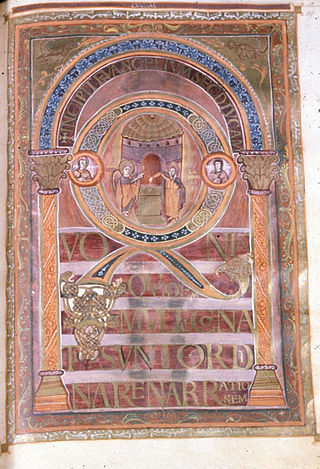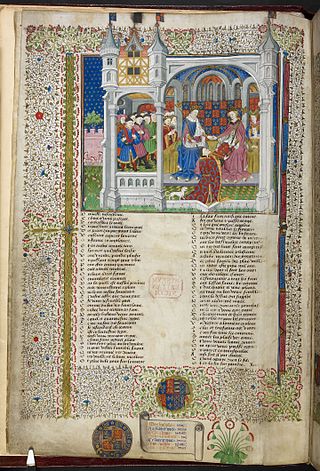
The Lindisfarne Gospels is an illuminated manuscript gospel book probably produced around the years 715–720 in the monastery at Lindisfarne, off the coast of Northumberland, which is now in the British Library in London. The manuscript is one of the finest works in the unique style of Hiberno-Saxon or Insular art, combining Mediterranean, Anglo-Saxon and Celtic elements.

The Book of Nunnaminster is a 9th-century Anglo-Saxon prayerbook. It was written in the kingdom of Mercia, using an "insular" hand, related to Carolingian minuscule. It was probably later owned by Ealhswith, wife of Alfred the Great. It is related to, but of an earlier date than, the Book of Cerne, and also to the Royal Prayerbook and the Harleian prayerbook. Like Cerne it contains the Passion narratives of the four Gospels and a collection of non-liturgical prayers, many of which relate to the Passion. The Book of Nunnaminster shares some poems with the Book of Cerne. It also includes some decorated initials.

The Hereford Gospels is an 8th-century illuminated manuscript gospel book in insular script (minuscule), with large illuminated initials in the Insular style. This is a very late Anglo-Saxon gospel book, which shares a distinctive style with the Caligula Troper. An added text suggests this was in the diocese of Hereford in the 11th century.

The Melisende Psalter is an illuminated manuscript commissioned around 1135 in the crusader Kingdom of Jerusalem, probably by King Fulk for his wife Queen Melisende. It is a notable example of Crusader art, which resulted from a merging of the artistic styles of Roman Catholic Europe, the Eastern Orthodox Byzantine Empire and the art of the Armenian illuminated manuscript.

British Library, Harley MS 1775 is an illuminated Gospel Book produced in Italy during the last quarter of the 6th century. The text is in Latin and is a mixture of the Vulgate and Old Latin translations. This text is called "source Z" in critical studies of the Latin New Testament.

British Library, Add MS 40618 is a late 8th century illuminated Irish Gospel Book with 10th century Anglo-Saxon additions. The manuscript contains a portion of the Gospel of Matthew, the majority of the Gospel of Mark and the entirety of the Gospels of Luke and John. There are three surviving Evangelist portraits, one original and two 10th century replacements, along with 10th century decorated initials. It is catalogued as number 40618 in the Additional manuscripts collection at the British Library.

British Library, MS Cotton Tiberius C. II, or the Tiberius Bede, is an 8th-century illuminated manuscript of Bede's Historia ecclesiastica gentis Anglorum. It is one of only four surviving 8th-century manuscripts of Bede, another of which happens to be MS Cotton Tiberius A. XIV, produced at Monkwearmouth–Jarrow Abbey. As such it is one of the closest texts to Bede's autograph. The manuscript has 155 vellum folios. This manuscript may have been the Latin text on which the Alfredian Old English translation of Bede's Ecclesiastical History was based. The manuscript is decorated with zoomorphic initials in a partly Insular and partly Continental style.

British Library, Egerton MS 609 is a Breton Gospel Book from the late or third quarter of the ninth century. It was created in France, though the exact location is unknown. The large decorative letters which form the beginning of each Gospel are similar to the letters found in Carolingian manuscripts, but the decoration of these letters is closer to that found in insular manuscripts, such as the Book of Kells and the Lindisfarne Gospels. However, the decoration in the Breton Gospel Book is simpler and more geometric in form than that found in the Insular manuscripts. The manuscript contains the Latin text of St Jerome's letter to Pope Damasus, St. Jerome's commentary on Matthew, and the four Gospels, along with prefatory material and canon tables. This manuscript is part of the Egerton Collection in the British Library.

The British Library is a research library in London that is the national library of the United Kingdom. It is one of the largest libraries in the world. It is estimated to contain between 170 and 200 million items from many countries. As a legal deposit library, the British Library receives copies of all books produced in the United Kingdom and Ireland, including a significant proportion of overseas titles distributed in the UK. The Library is a non-departmental public body sponsored by the Department for Culture, Media and Sport.

The Harleian Library, Harley Collection, Harleian Collection and other variants is one of the main "closed" collections of the British Library in London, formerly the library of the British Museum.

Minuscule 699, δ104, is a Greek minuscule manuscript of the New Testament, on parchment. Palaeographically it has been assigned to the 11th century. Some leaves of the manuscript were lost. Scrivener labelled it by 603e.
The Egerton Collection is a collection of historical manuscripts held in the British Library. The core of the collection comprises 67 manuscripts bequeathed to the British Museum in 1829 by Francis Henry Egerton, 8th Earl of Bridgewater, along with £12,000. To this sum a further £3000 was added in 1838 by Egerton's cousin, Charles Long, 1st Baron Farnborough. The income from the bequests is devoted to the purchase of further manuscripts, which are added to the original collection. This means that the Egerton series, unlike most other named series of manuscripts held by the Library, remains open to new accessions.

The Royal manuscripts are one of the "closed collections" of the British Library, consisting of some 2,000 manuscripts collected by the sovereigns of England in the "Old Royal Library" and given to the British Museum by George II in 1757. They are still catalogued with call numbers using the prefix "Royal" in the style "Royal MS 2. B. V". As a collection, the Royal manuscripts date back to Edward IV, though many earlier manuscripts were added to the collection before it was donated. Though the collection was therefore formed entirely after the invention of printing, luxury illuminated manuscripts continued to be commissioned by royalty in England as elsewhere until well into the 16th century. The collection was expanded under Henry VIII by confiscations in the Dissolution of the Monasteries and after the falls of Henry's ministers Cardinal Wolsey and Thomas Cromwell. Many older manuscripts were presented to monarchs as gifts; perhaps the most important manuscript in the collection, the Codex Alexandrinus, was presented to Charles I in recognition of the diplomatic efforts of his father James I to help the Eastern Orthodox churches under the rule of the Ottoman Empire. The date and means of entry into the collection can only be guessed at in many if not most cases. Now the collection is closed in the sense that no new items have been added to it since it was donated to the nation.

The Landévennec Group is a group of 10th and 11th century illuminated manuscripts of the Four Evangelists from Basse-Bretagne, probably all from the scriptorium of Landévennec Abbey. Influenced by insular art, they are marked by their representation of the evangelists as humans with animal heads.
Sir George Frederic Warner, FBA, FSA was an English archivist; he was Keeper of Manuscripts and Egerton Librarian at the British Museum from 1904 to 1911.
A Gospel Book is a book, especially a manuscript book, containing gospels of the Christian New Testament. See Category:Gospel Books.













